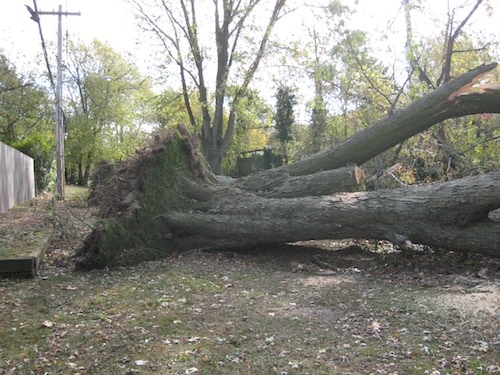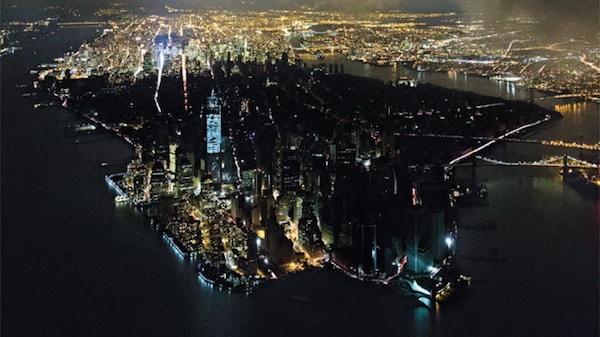First there was a thunderous clap followed by a crash that took out our electricity. Like a series of dominoes, the houses stretching down our block went black one by one. Husband and I ran downstairs to see branches and limbs blown up against every window on the first floor of our home and more sailing by like toys in the wind. We strained our eyes to see out the picture window overlooking our back deck, but the inky darkness hid what the morning would reveal.
We came to count ourselves lucky in the aftermath of Hurricane Sandy. Our house would escape flooding and we would avoid devastating misfortune. At midnight, though, at the height of what was already clear would be a long term disaster, I stood in our front doorway with my hood up over my head and a flashlight in my hand and watched the street I’ve called home for 25 years become a river. The unforgiving wind had eased, but the water came and it came and it came some more until it was halfway up our front lawn and nipping at the rear wheels of Husband’s car parked inches from the front door.
Tidal water from the stream behind our neighborhood filled the streets and cul-de-sacs of our community and I watched it for hours like a video on YouTube, a weather nightmare happening somewhere else. I didn’t need a yardstick to tell how deep the street was submerged. I just watched the murky rushing avalanche creep up the sides of the cars parked along the curbs until it covered the door handles and lapped the side view mirrors. Weeks later, those flooded out cars remain on the street in front of our house awaiting insurance adjusters and tow trucks. The knowledge that none of them are ours brings no joy. They belong to our neighbors. Our friends.
The once idyllic tree-lined lanes that wind through our neighborhood now look post-apocalyptic, like a scene from Cormac McCarthy’s The Road. On the other side of town, falling trees tore off a piece of Son’s roof and one landed dead center on top of his next door neighbor’s house. Daughter reported from the city that her 20-story apartment building went dark with the Union Square transformer explosion. She and Boyfriend walked down fourteen flights and over to First Avenue to find the highway along the East River deserted and submerged, the tunnels and subways that form the city’s arteries battered, the South Street Seaport all but washed away.
Below 24th Street, the city was silent, pitch-black and otherworldly. New York magazine’s cover the following week became instantly iconic with its aerial shot of a half-dark Manhattan taken by photographer Iwan Baan. Never were the haves and have nots more viscerally divided.
As if New York hadn’t been pummeled sufficiently, the week following Sandy brought a nor’easter that dumped seven inches of snow on houses already frozen without heat and power. Gasoline became scarce and rationing began once again evoking The Road only more so, with fights breaking out on gas lines between otherwise peaceful people whose tempers were frayed to the breaking point. Stories of heartwarming compassion piled on top of incidents of frightening violence; our best and worst hours mixing together like everything in New York seems to mix together. Uneasily, but all our own.
It will be many more months, perhaps years, before the full impact of the storm is absorbed. People lost their homes, their businesses, some lost their lives. First responders are already suffering from respiratory ailments contracted in the Rockaways, Staten Island, Breezy Point and other areas of devastation where the people they came to help were forced to remain in conditions that became ever more squalid with too little relief. But some good things have resulted. Heads have rolled at power companies rendered inexcusably powerless and unprepared for a storm of Sandy’s magnitude, a Frankenstorm. The wake up call has sounded and woe be to the agencies entrusted with the public’s well-being that ignore it from this moment forward. Nature has made it abundantly clear that the dreaded hundred year flood will come more than once in our lifetime.
New Yorkers have again become close allies as they did after 9/11. People lean on strangers for support without hesitation. A day does not go by that the storm’s aftermath is not front and center in our collective reality. On line at Trader Joe’s yesterday, an overheard conversation revealed that the speaker lived in Long Beach, one of the area’s most devastated towns. The entire line of shoppers became involved in the conversation when the woman said her house would have to be demolished and rebuilt. Phone numbers were passed for contractors, electricians, offers to help resonated long after I was past the check out. There will be more good to come, but sadly, the buckets of bad are not behind us yet.
Today’s Foto celebrates something not only good, but wonderful. Three weeks after Hurricane Sandy, Son and his lovely Fiancée tied the knot in a ceremony filled with joy, love and laughter. I wish you all the same.



